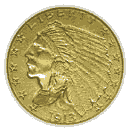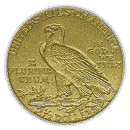$5 Indian


Description
In 1908 numismatists were surprised by the new design of the Quarter and half eagle. Sculptor Bela Lyon Pratt, chose to recess areas of design that were once shown in relief and raised the field of the coin to become the highest portion. This was a distinct departure from previous design techniques.
The obverse of the Pratt quarter eagle, known as the Indian Head type, features an Indian chief facing left, with LIBERTY above, six stars to the left and seven to the right, and the date below. The reverse shows an eagle perched on a branch or log, with UNITED STATES OF AMERICA above, E PLLTRIBUS UNUM to the left, IN GOD WE TRUST to the right and the denomination expressed as 2 1/2 DOLLARS below.
Examples were produced at the Philadelphia Mint from 1908 through 1915 and again from 1925 through 1929. Denver Mint pieces were produced in 1911, 1914 and 1925, with the 1911-D considered to be the rarity of the series.
The type set collector can easily find examples of the Indian Head quarter eagle in grades from Very Fine to AU. Uncirculated pieces are scarce, and superb Uncirculated pieces are very scarce. The scarcity of higher grade pieces is explained not by the mintage's, which in most instances were generous, but by the format of the coin.
Valuation
- COIN NAME
- $5 Indian
- DESIGNED BY
- Bela Lyon Pratt
- ISSUE DATE
- 1908-1929
- COMPOSITION
- 0.900 part gold, 0.100 part copper
- DIAMETER
- 18 mm
- WEIGHT
- 64.5 grains
- EDGE
- Reeded
- BUS MINT
- 7,230,261
- PROOF MINT
- 1,827
The statements made on this Website are opinions only. Past results are no guarantee of future performance or returns. Precious metals, like all investments, carry risk. Precious metals and coins may appreciate, depreciate, or stay the same depending on a variety of factors. Lear Capital, LLC cannot guarantee, and makes no representation, that any metals purchased will appreciate at all or appreciate sufficiently to make customers a profit. Lear is a retail seller of precious metals and its buyback (or bid) prices are lower than its sell (or ask) prices. Metals must appreciate enough to account for this difference in order for customer to make a profit when liquidating the metals. Lear does not provide financial advice or retirement planning services. The decision to purchase or sell precious metals, and which precious metals to purchase or sell, are the customer’s decision alone, and purchases and sales should be made subject to the customer’s own research, prudence and judgment.